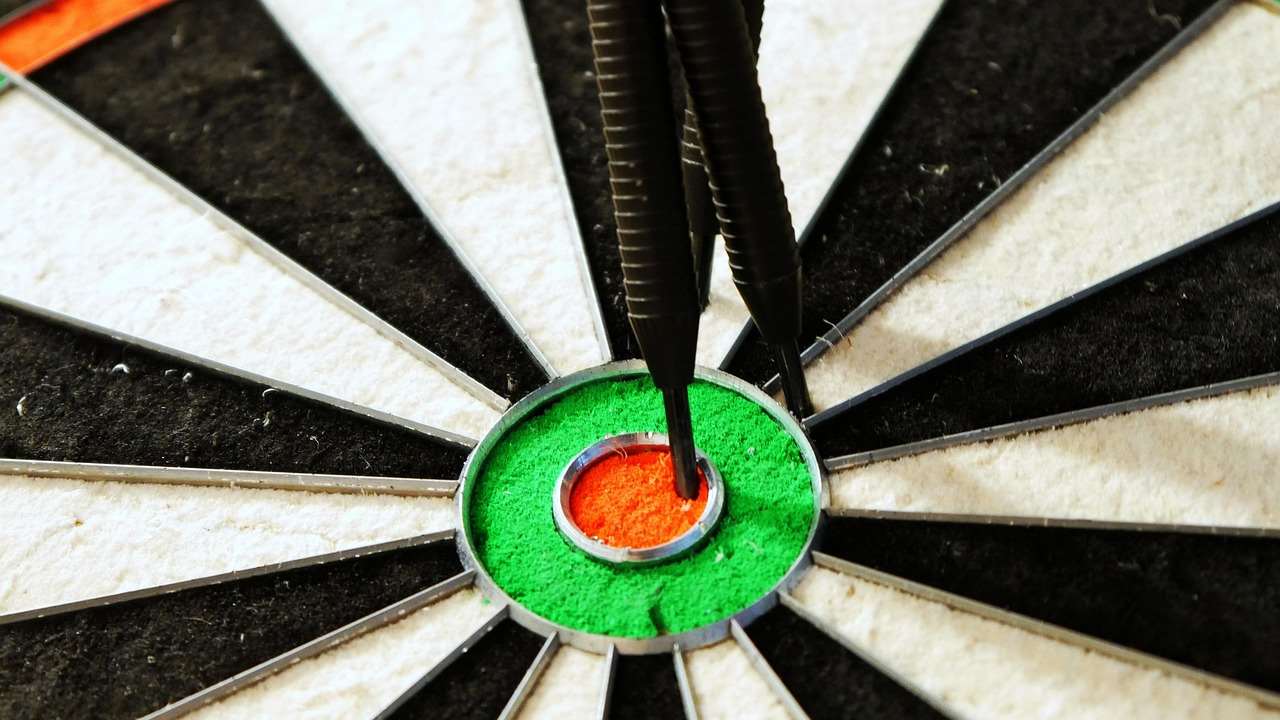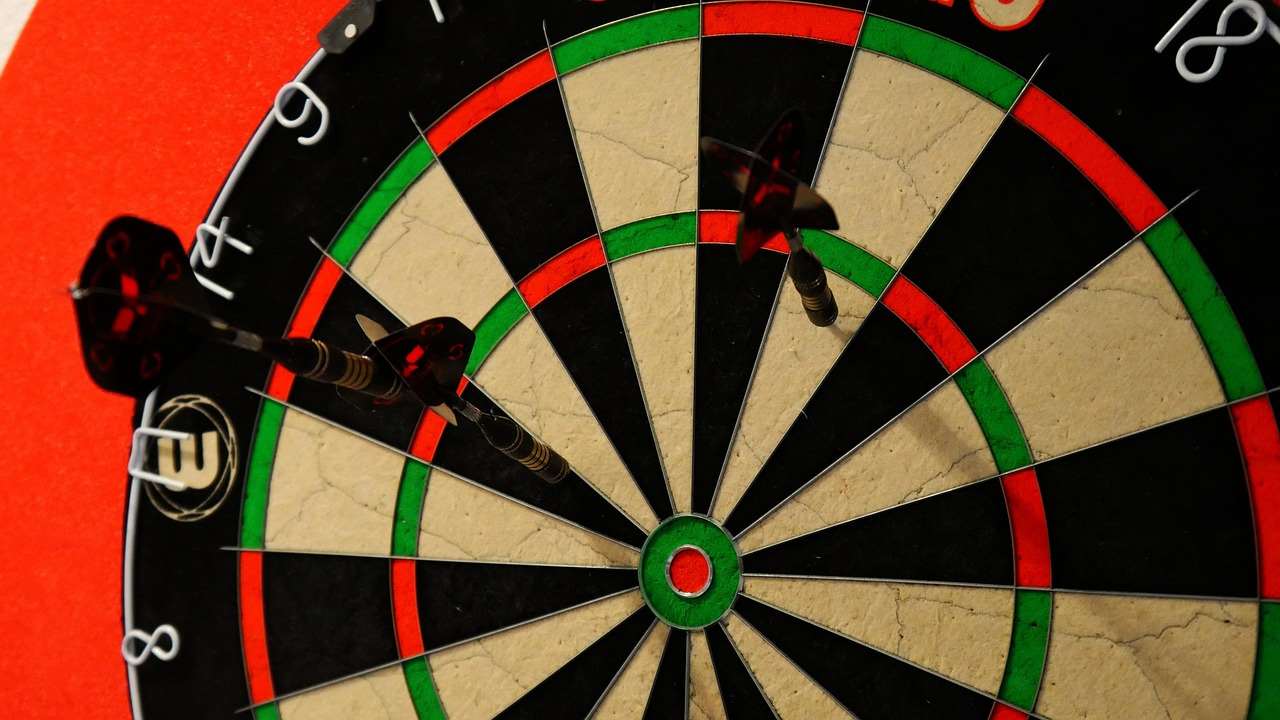Choosing darts for beginners can seem daunting, but the key is to focus on finding a set that feels comfortable and encourages consistent throws. This article will guide you through the essential factors to consider, helping you make an informed decision and start your darts journey confidently. We’ll cover everything from weight and material to grip and overall style to ensure you can find the perfect darts for your needs.
⚠️ Still Using Pen & Paper (or a Chalkboard)?! ⚠️
Step into the future! The Dart Counter App handles all the scoring, suggests checkouts, and tracks your stats automatically. It's easier than you think!
Try the Smart Dart Counter App FREE!Ready for an upgrade? Click above!
Before diving into the specifics of choosing your first set of darts, let’s talk about why the right equipment matters. Choosing the right darts for beginners is crucial because it directly impacts your learning process and enjoyment. An ill-fitting set can lead to frustration and bad habits that are difficult to break later on. Investing a little time upfront in careful selection pays off massively in the long run.
Understanding the fundamental aspects of dart construction will help you understand what characteristics are most important when choosing darts for beginners. For example, different barrel shapes, materials, and weights offer varying levels of grip and balance, and therefore impact the way the dart feels in your hand and flies toward the board. It’s a question of personal preference that can often only be answered by trying different options and seeing what feels best.
Choosing Darts for Beginners: Weight and Balance

One of the most crucial aspects of choosing darts for beginners is the weight. Beginner players often gravitate towards lighter darts (between 20-24 grams), as these are easier to throw accurately initially. However, this isn’t a strict rule; experiment with different weights to find what feels comfortable and allows for a consistent release. The weight should feel natural in your hand, not too heavy or too light. The heavier the dart, the more momentum it carries; however, heavier darts are more challenging to control, especially for novices.
Balance is equally important. Choosing darts for beginners with a well-balanced barrel allows for a smooth and controlled throw. A dart with a poorly balanced barrel can cause it to wobble or veer off course. You can test the balance of a dart by placing it on your finger; it should stay level. If it tips to one side, the balance is off. Many beginners overlook this aspect, but it can significantly impact accuracy.
Finding Your Ideal Weight
Many dart retailers offer sample darts or allow for returns. Take advantage of this by trying out different weights to discover what feels best for you. You might find that a lighter weight initially helps develop good throwing techniques, but as you improve, you may prefer a heavier dart for more power. Don’t feel limited by what you think you need, as your preference may change over time.
Choosing Darts for Beginners: Materials and Grip

Darts are typically made from brass, tungsten, or nickel-silver. Choosing darts for beginners often means selecting brass darts, which are more affordable and less dense than tungsten. Tungsten darts are favored by professionals as their higher density allows for a thinner barrel in the same weight. The thinner barrels typically provide better accuracy. However, for beginners, brass darts are an excellent entry point.
The grip is another critical factor in choosing darts for beginners. The grip affects how well you hold and control the dart during your throw. Different dart styles have various grip patterns. Some common types include:
- Straight barrels: These offer minimal grip and provide more control for those who prefer a simple, straightforward throw.
- Ringed barrels: These have rings etched into the barrel that provide a tactile grip.
- Knurled barrels: These have a textured surface that creates friction for a better grip.
Experiment with different grip styles to find one that suits your preferences and throwing style. You might find that a slightly more aggressive grip suits your throwing style. If you find yourself slipping on the barrel, it’s worth trying a dart with a more defined grip. It is easier to develop proper techniques when you feel comfortable and secure with the dart in hand.
Choosing Darts for Beginners: Length and Barrel Shape
The length and shape of the barrel also influence the feel and flight of the dart. Choosing darts for beginners often involves selecting shorter barrels (around 40mm to 45mm), which tend to be easier to control. Longer barrels (over 50mm) can be more challenging to handle effectively for beginners.
Many beginners opt for a cylindrical barrel shape as the most intuitive, but other shapes exist. The barrel shape is a highly personalized aspect of dart selection and should be chosen based on your overall comfort. It’s often advisable to try a few dart shapes before making a decision. A more front-loaded barrel, for example, can help reduce the effort needed to achieve the desired throw, whereas a rear-weighted one enhances stability. Again, experimentation is your friend.
Choosing Darts for Beginners: Flights and Shafts
While the barrel is the primary element of the dart, the flights and shafts play essential roles. Flights are the fins at the end of the dart that stabilize its flight. Standard flights are usually fine for beginners; however, if you have issues with wobble or inconsistent flight, you might consider experimenting with different flight shapes and sizes. There are various shapes and sizes to choose from, with some designed for more stability or speed.
The shafts connect the barrel to the flights and should provide a secure fit. Choosing darts for beginners often means using standard nylon shafts. You’ll want to ensure these are snug on both the barrel and the flights, as any movement could affect the dart’s flight path and consistency.
Remember, these are all aspects to consider when choosing darts for beginners. The best approach is to try out different options and see what works best for your individual needs. The Darts Counter App (Dart Counter App) can also help track your scores and performance with different sets of darts!
Choosing Darts for Beginners: Where to Buy
You can find darts in many places, from sporting goods stores to online retailers. Online retailers often have a wider selection, and it is often possible to read reviews and find what other users think about specific darts. However, if possible, the opportunity to physically try a dart in your hand and test its weight and balance is still highly recommended.
It is also worth considering buying a dartboard and starting with a basic, inexpensive set of darts when first learning to play darts. Dartboard types and features can also impact your play, and it is worth understanding them to maximize your game. This avoids a large upfront investment and allows you to determine if you enjoy the game before investing in more advanced equipment. As you become more experienced, you can explore higher-quality, more specialized darts.
Choosing Darts for Beginners: Practice Makes Perfect

No matter what darts you choose, consistent practice is essential to improving your skill. Darts practice games are a fun way to enhance your skills and learn new techniques. Choosing darts for beginners is only the first step; practice is key to developing accuracy, consistency, and a smooth throwing style. It is a good idea to focus on learning good technique before concentrating too much on the small details of the dart equipment itself.
Start with simple practice routines focusing on consistent aim and release. Over time, you can incorporate more advanced techniques and game styles. If you are concerned about injuries, it is always a good idea to read up on preventing darts injuries so you can play safely.
Choosing Darts for Beginners: Beyond the Basics
Once you’ve mastered the basics, you can explore more advanced dart features. Consider the impact of different dart materials on the flight and weight, and learn how the grip design can change your game. Experiment with different flight shapes and shafts and see how these affect consistency. There are many resources online dedicated to helping you master the game and learn how to choose the best darts for your skill level.
Explore various dart games to add variety to your practice sessions. Fun darts games for practice are great for learning new techniques and developing game sense. Around the Clock darts game, Shanghai darts game rules, and others provide various ways to practice different skills. Use a online dart score keeper or how to use a dart counter app to track your progress over time. Remember, it is a long game, and continuous improvement is the goal. This includes working on your physical fitness, as darts fitness for players can be critical to your overall success.

Choosing Darts for Beginners: Conclusion
Choosing darts for beginners might feel overwhelming initially, but breaking it down into manageable steps makes the process much simpler. Consider weight, balance, material, grip, length, and barrel shape. Experiment with different styles to find what feels most comfortable and helps you throw consistently. Remember that practice is vital, so enjoy the process of learning and refining your game. Soon you’ll be throwing darts like a pro!
Hi, I’m Dieter, and I created Dartcounter (Dartcounterapp.com). My motivation wasn’t being a darts expert – quite the opposite! When I first started playing, I loved the game but found keeping accurate scores and tracking stats difficult and distracting.
I figured I couldn’t be the only one struggling with this. So, I decided to build a solution: an easy-to-use application that everyone, no matter their experience level, could use to manage scoring effortlessly.
My goal for Dartcounter was simple: let the app handle the numbers – the scoring, the averages, the stats, even checkout suggestions – so players could focus purely on their throw and enjoying the game. It began as a way to solve my own beginner’s problem, and I’m thrilled it has grown into a helpful tool for the wider darts community.